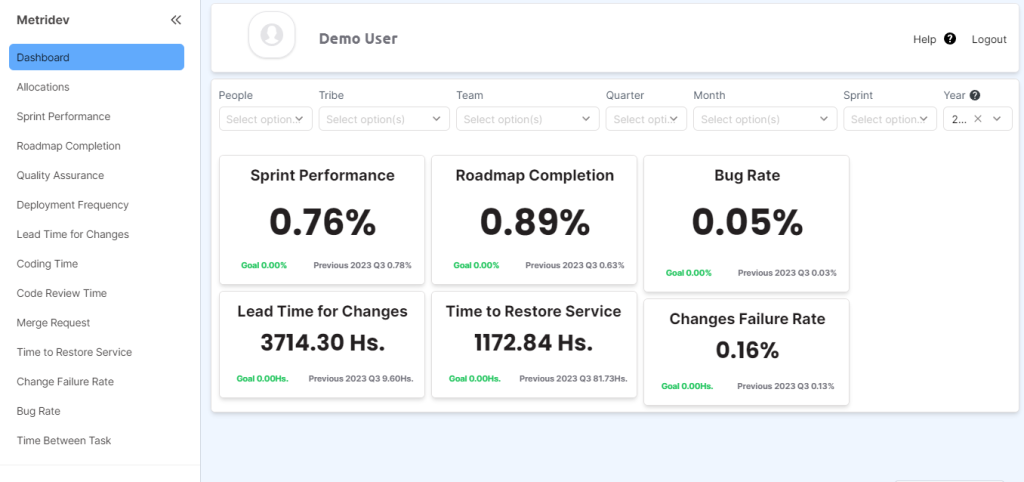Introduction to Sprint Performance Metrics
Sprint Performance is a critical aspect of software development that directly impacts the success of an agile team. In
order to optimize sprint performance, it is crucial to understand the meaning behind sprint performance metrics. A
sprint, in the context of software development, refers to a fixed duration of time during which a team works on a set of
predefined tasks or user stories. Sprint performance, therefore, refers to the ability of a team to effectively complete
these tasks within the given time frame.
Why Data-Driven Metrics are Essential for Optimizing Sprint Performance
Data-driven metrics play a crucial role in optimizing sprint performance. By leveraging data, teams can gain valuable
insights into their performance, identify areas for improvement, and make data-backed decisions to enhance their
productivity. Data-driven metrics provide a quantitative measure of a team’s performance, allowing for more accurate
analysis and evaluation.
Sprint Performance Reports: Measuring Sprint Productivity

Sprint productivity can be effectively measured through the use of various metrics that provide valuable insights into the team’s performance. These metrics play a crucial role in evaluating the team’s progress.
Some of the key metrics used in measuring sprint performance include Velocity, this is a metric that measures the amount of work a team can complete within a sprint. Velocity helps teams estimate the amount of work they can accomplish in future sprints, allowing for better planning and resource allocation.
Also Burndown Chart, is a visual representation of the remaining work in a sprint over time. It provides a clear picture of how the team is progressing towards completing all the planned work within the sprint duration. By tracking the actual progress against the ideal progress line, teams can identify if they are on track or if adjustments need to be made.
And lastly, another key metric is the Cycle time, measures the time it takes for a user story or task to move from start to finish. It helps teams identify bottlenecks and areas where the workflow can be optimized to reduce the time. By analyzing cycle times, teams can identify areas for improvement and implement strategies to streamline their processes.
By utilizing these metrics, teams can gain valuable insights into their performance, identify trends and patterns, and make data-driven decisions. These Sprint Performance metrics not only provide a clear picture of the team’s productivity but also help in identifying potential issues and taking proactive measures to address them.
Key Metrics for Evaluating Sprint Performance
To effectively evaluate sprint performance, teams should focus on several key metrics that provide valuable insights into their overall performance and the success of their sprint performance. One of these metrics is the sprint goal achievement, which measures the team’s ability to successfully accomplish the goals set for a sprint. This metric helps assess the team’s performance and their adherence to sprint objectives.
Another important metric to consider is defect density, which measures the number of defects found in the software per unit of work completed. A low defect density indicates high-quality work and efficient development practices.
Customer satisfaction is another crucial metric for evaluating sprint performance. It looks at how well the team’s deliverables meet the expectations of the end-users. This metric can be measured through surveys or feedback mechanisms. By prioritizing customer satisfaction, teams can prioritize user-centric development and ensure that their deliverables are meeting the needs and expectations of their target audience.
How to Create a Sprint Performance Report
Creating a comprehensive sprint report involves gathering and analyzing data to provide an overview of the team’s performance.
The first step is to define the report scope by determining the specific metrics and data points that will be included. This step is crucial as it ensures that the report aligns with the goals and objectives of the team. Once the scope is defined, the next step is to collect relevant data from various sources. This can include data from task management tools, version control systems, and team collaboration platforms. After collecting the data, the next step is to analyze it. Data analysis techniques can be used to uncover insights and trends within the collected data. This analysis helps identify areas for improvement and highlight noteworthy achievements. Finally, present the findings of the data analysis in a clear and concise manner. Visualizations such as charts and graphs can be used to make the information easily understandable and digestible for stakeholders and team members.
By following these steps, teams can create comprehensive sprint reports that provide valuable insights into their performance and help drive continuous improvement.
The Benefits of Using a Data-Driven Metrics Software

Utilizing a data-driven metrics software can offer numerous benefits for optimizing Sprint Performance. These benefits include improved decision-making, enhanced collaboration, and most importantly, continuous improvement, let´s profundize:
One of the key advantages of using data-driven metrics software is improved decision-making. By providing teams with accurate and real-time data, the software enables them to make informed decisions based on objective information rather than subjective judgments. This helps teams to prioritize tasks,
Another benefit is enhanced collaboration. The software provides a central platform for data analysis and reporting, allowing team members to access and share information easily. This promotes collaboration among team members and improves transparency, as everyone has access to the same data.
Furthermore, data-driven metrics software enables continuous improvement. By analyzing the data, teams can identify areas for improvement and make data-backed adjustments to their sprint performance. This continuous improvement cycle helps teams refine their processes, optimize their productivity, and achieve their goals more efficiently.
This way, implementing a data-driven metrics software that captures and analyzes these metrics can significantly enhance a team’s sprint performance and overall success.
How to Choose and implement the right Data-Driven Metrics Software for Your Team
When selecting a data-driven metrics software for your team, consider the following factors, compatibility is crucial, ensure that the software integrates seamlessly with your existing project management and
collaboration tools, allowing for smooth data flow and analysis. This integration will provide a general view of your team’s performance. Additionally, customization is essential, look for a software that allows you to customize the metrics and reports according to your team’s specific. This customization will ensure that you are measuring the right metrics that align with your team’s goals and strategies.
Furthermore, the ease of use is a significant factor to consider, choose a software that is user-friendly and intuitive, enabling team members to easily navigate and analyze the data without requiring extensive training. An intuitive interface will encourage adoption and engagement with the software, leading to more effective utilization of the metrics.
Now, to successfully implement this data-driven metrics software to track and improve your sprint performance, firstly you should set clear objectives to define the goals and align efforts towards measuring the success of the implementation. Next, provide comprehensive training to your team members to equip them with the necessary skills and knowledge to effectively use the software, this includes understanding the metrics, interpreting the data, and utilizing the software’s features. Continuously monitor and evaluate the impact of the software on your team’s sprint performance. Regularly review the metrics and reports generated by the software to identify areas for improvement and track progress towards your objectives. Make adjustments and improvements as needed to maximize the benefits of the software.
Tips and Strategies for Maximizing Sprint Performance Potential
To maximize sprint performance potential, it is crucial to implement certain tips and strategies. First and foremost, establishing clear communication channels is essential. This ensures effective collaboration, transparency, and timely decision-making among team members. Additionally, prioritize and refine user stories is key. By prioritizing user stories based on their value and complexity, and regularly refining them to ensure they are well-defined and achievable within a sprint, teams can stay focused and work towards achievable goals. Lastly, implementing continuous integration and deployment practices can greatly streamline the development process and reduce the time taken to deliver working software. This helps in maintaining a smooth workflow and improving sprint performance.
How to Measure Performance in Agile
In agile software development, performance measurement is crucial to evaluate the team’s progress and identify areas
for improvement. Key performance indicators (KPIs) commonly used in agile include:
Lead Time: Lead time measures the time taken from the initiation of a user story to its completion. It helps teams
identify bottlenecks and optimize their workflow.
Cycle Time: Cycle time, as mentioned earlier, measures the time taken for a user story or task to move from start
to finish.
Defect Removal Efficiency: Defect removal efficiency measures the effectiveness of the team’s testing and
quality assurance processes in identifying and resolving defects.
Common Challenges in Sprint Performance Metrics
While implementing and utilizing sprint performance metrics, teams may face some common challenges. One such challenge is ensuring the accuracy and reliability of the data used for metrics. It is crucial to have proper data collection processes in place to minimize errors and inconsistencies.
Another challenge is resistance to change. Some team members may resist adopting data-driven metrics due to unfamiliarity or fear of scrutiny. Addressing concerns and providing proper training can help overcome this challenge.
Conclusion: Harnessing the Power of Data for Improved Sprint Performance
In conclusion, leveraging data-driven metrics software is essential for optimizing sprint performance. By utilizing key metrics and reports, teams can gain valuable insights into their performance, make data-backed decisions, and continuously improve their sprint productivity. Choosing the right data-driven metrics software and implementing it effectively can unlock the full potential of your team, leading to increased efficiency, collaboration, and ultimately, better software development outcomes.
If you want to learn more about metrics, read our article about DORA Metrics
IT METRICS TO BECOME AN EXPERT














Leave a Reply